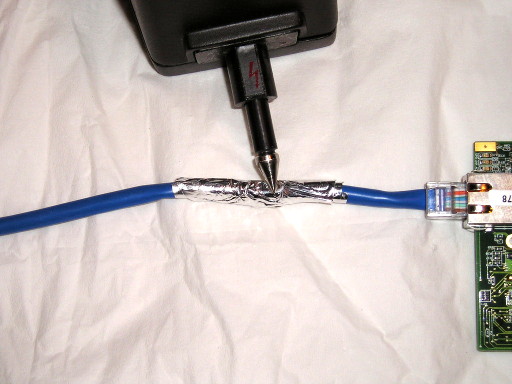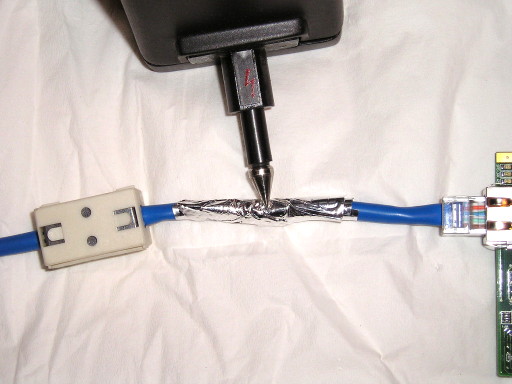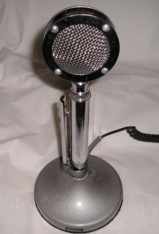
Figure 1. Injecting ESD Current Capacitively Into a Cable Using Aluminum Foil
Abstract: When a piece of
equipment is subjected to ESD, the cause of the resulting system
response can be difficult to find because the ESD event couples to many
parts of the system, not just the place where the event happened. A
technique is described that allows ESD energy to be coupled onto system
cables, one at a time. Doing so can identify sensitive cables that may
be contributing to an ESD problem.
Discussion: Figure 1 shows a
CAT5 Ethernet cable connected to a small circuit board (the other
cables are not shown). The Ethernet cable is wrapped for several cm
with aluminum foil and an ESD simulator is used to produce a contact
discharge to the aluminum foil. This injects a significant amount of
high frequeny current into the cable and as the voltage level of the
simulator is turned up, one can determine the sensitivity to ESD of a
particular cable. The amount of injected current can be determined
by the following formula:
For only one picofarad of capacitance and a 2000 Volt change in a nanosecond we get:
There is quite a bit more than one picofarad of capacitance between the aluminum foil and the Ethernet cable, so many Amperes of peak current will be injected. Some of the current will go to the left, down the cable, instead of into the board. We can minimize this current to the left by putting a ferrite core on the cable as shown in Figure 2. For a more detailed explanation of how current behaves with capacitive and inductive coupling, see my April 2005 Technical Tidbit, Inductive and Capacitive Coupling - Induced Current Characteristics.

Figure 2. Injecting ESD Current Capacitively Into a Cable Using Aluminum Foil and a Ferrite Core
q = CV
by differentiating with respect to time we get:
dq/dt = i = Cdv/dt
by differentiating with respect to time we get:
For only one picofarad of capacitance and a 2000 Volt change in a nanosecond we get:
i = (10**-12 F) x (2000V/10**-9 sec) = 2 Amperes!
There is quite a bit more than one picofarad of capacitance between the aluminum foil and the Ethernet cable, so many Amperes of peak current will be injected. Some of the current will go to the left, down the cable, instead of into the board. We can minimize this current to the left by putting a ferrite core on the cable as shown in Figure 2. For a more detailed explanation of how current behaves with capacitive and inductive coupling, see my April 2005 Technical Tidbit, Inductive and Capacitive Coupling - Induced Current Characteristics.

Figure 2. Injecting ESD Current Capacitively Into a Cable Using Aluminum Foil and a Ferrite Core
The basic method is to apply this
stress to each system cable, one at a time starting
at a low setting of the ESD simulator, about 500 Volts, and then
gradually raising the level until a response is noted. If the response
is the same as an ESD problem one is trying to fix, there is a good
chance that the cable and the part of the system to which it is
connected are associated with the ESD problem
With most ESD simulators, the foil
must be discharged between contact discharges from the ESD simulator.
This can be accomplished by connecting a few one megohm resistors in
series to a suitable ground. Note that thin film resistors may be
destroyed by ESD so use composition or other resistors that rely on the
bulk properties of the resistive material and are physically large
enough to prevent voltage breakdown. The KeyTek Mini-Zap ESD simulator provides such a leakage path automatically.
Summary:
A simple method was described for finding cables in a system that are
sensitive to an ESD stimulus. The method is easy and quick to apply and
can be used proactively to find ESD issues before formal testing, or to
troubleshoot existing problems. This method should also be useful for
problems associated with electrical fast transients such at those
described in IEC 61000-4-4.
Additional articles on this website related to this topic are:
- February 2002, Cable Effects Part 2: Inductive Pickup by Cables in a System
- March 2002, Cable Effects Part 3: Capacitive Pickup by Cables in a System
- April 2005, Inductive and Capacitive Coupling - Induced Current Characteristics
Click here for a description of my latest seminar titled (now also available online as a WebEx seminar):
EMC
Lab Techniques for Designers
(How to find EMC problems and have some confidence your system will pass EMC testing while it is still in your lab).
(How to find EMC problems and have some confidence your system will pass EMC testing while it is still in your lab).
Home

